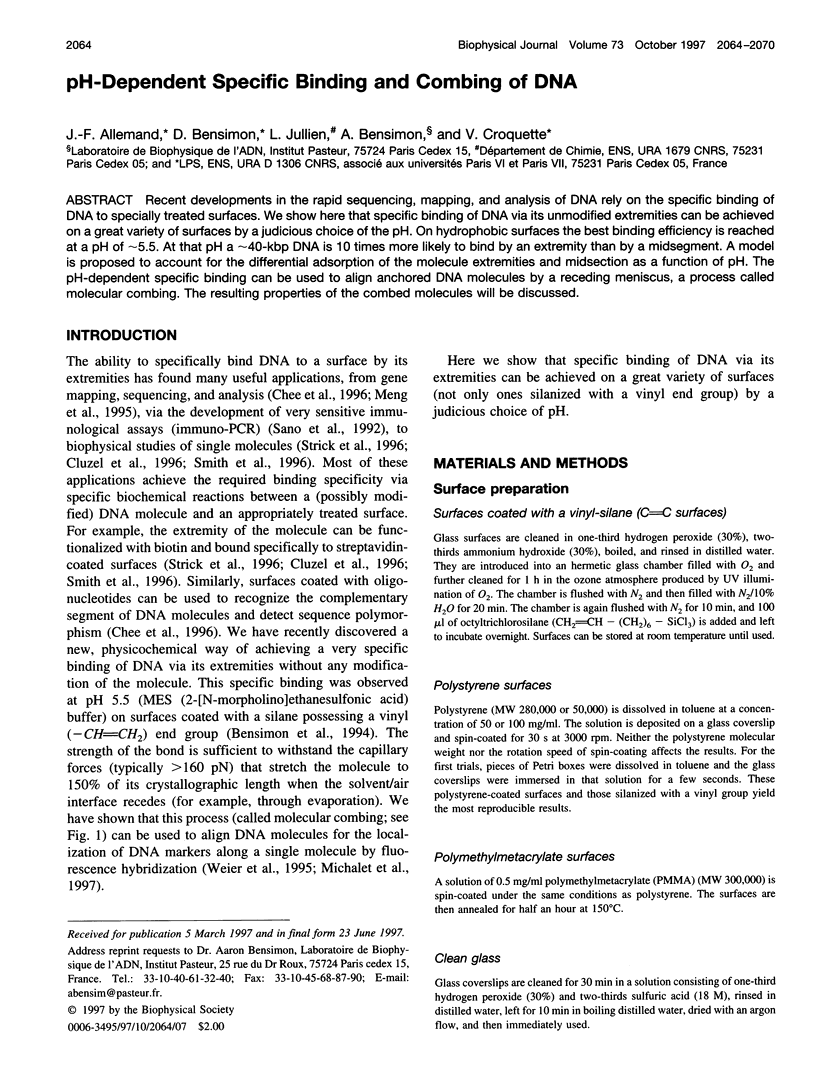Abstract
Recent developments in the rapid sequencing, mapping, and analysis of DNA rely on the specific binding of DNA to specially treated surfaces. We show here that specific binding of DNA via its unmodified extremities can be achieved on a great variety of surfaces by a judicious choice of the pH. On hydrophobic surfaces the best binding efficiency is reached at a pH of approximately 5.5. At that pH a approximately 40-kbp DNA is 10 times more likely to bind by an extremity than by a midsegment. A model is proposed to account for the differential adsorption of the molecule extremities and midsection as a function of pH. The pH-dependent specific binding can be used to align anchored DNA molecules by a receding meniscus, a process called molecular combing. The resulting properties of the combed molecules will be discussed.
Full text
PDF






Images in this article
Selected References
These references are in PubMed. This may not be the complete list of references from this article.
- Belotserkovskii B. P., Johnston B. H. Polypropylene tube surfaces may induce denaturation and multimerization of DNA. Science. 1996 Jan 12;271(5246):222–223. doi: 10.1126/science.271.5246.222. [DOI] [PubMed] [Google Scholar]
- Benight A. S., Wartell R. M. Influence of base-pair changes and cooperativity parameters on the melting curves of short DNAs. Biopolymers. 1983 May;22(5):1409–1425. doi: 10.1002/bip.360220512. [DOI] [PubMed] [Google Scholar]
- Bensimon A., Simon A., Chiffaudel A., Croquette V., Heslot F., Bensimon D. Alignment and sensitive detection of DNA by a moving interface. Science. 1994 Sep 30;265(5181):2096–2098. doi: 10.1126/science.7522347. [DOI] [PubMed] [Google Scholar]
- Bensimon D, Simon AJ, Croquette V, V, Bensimon A. Stretching DNA with a receding meniscus: Experiments and models. Phys Rev Lett. 1995 Jun 5;74(23):4754–4757. doi: 10.1103/PhysRevLett.74.4754. [DOI] [PubMed] [Google Scholar]
- Chee M., Yang R., Hubbell E., Berno A., Huang X. C., Stern D., Winkler J., Lockhart D. J., Morris M. S., Fodor S. P. Accessing genetic information with high-density DNA arrays. Science. 1996 Oct 25;274(5287):610–614. doi: 10.1126/science.274.5287.610. [DOI] [PubMed] [Google Scholar]
- Cluzel P., Lebrun A., Heller C., Lavery R., Viovy J. L., Chatenay D., Caron F. DNA: an extensible molecule. Science. 1996 Feb 9;271(5250):792–794. doi: 10.1126/science.271.5250.792. [DOI] [PubMed] [Google Scholar]
- Meng X., Benson K., Chada K., Huff E. J., Schwartz D. C. Optical mapping of lambda bacteriophage clones using restriction endonucleases. Nat Genet. 1995 Apr;9(4):432–438. doi: 10.1038/ng0495-432. [DOI] [PubMed] [Google Scholar]
- Parra I., Windle B. High resolution visual mapping of stretched DNA by fluorescent hybridization. Nat Genet. 1993 Sep;5(1):17–21. doi: 10.1038/ng0993-17. [DOI] [PubMed] [Google Scholar]
- Sano T., Smith C. L., Cantor C. R. Immuno-PCR: very sensitive antigen detection by means of specific antibody-DNA conjugates. Science. 1992 Oct 2;258(5079):120–122. doi: 10.1126/science.1439758. [DOI] [PubMed] [Google Scholar]
- Smith S. B., Cui Y., Bustamante C. Overstretching B-DNA: the elastic response of individual double-stranded and single-stranded DNA molecules. Science. 1996 Feb 9;271(5250):795–799. doi: 10.1126/science.271.5250.795. [DOI] [PubMed] [Google Scholar]
- Stein V. M., Bond J. P., Capp M. W., Anderson C. F., Record M. T., Jr Importance of coulombic end effects on cation accumulation near oligoelectrolyte B-DNA: a demonstration using 23Na NMR. Biophys J. 1995 Mar;68(3):1063–1072. doi: 10.1016/S0006-3495(95)80281-X. [DOI] [PMC free article] [PubMed] [Google Scholar]
- Strick T. R., Allemand J. F., Bensimon D., Bensimon A., Croquette V. The elasticity of a single supercoiled DNA molecule. Science. 1996 Mar 29;271(5257):1835–1837. doi: 10.1126/science.271.5257.1835. [DOI] [PubMed] [Google Scholar]
- Weier H. U., Wang M., Mullikin J. C., Zhu Y., Cheng J. F., Greulich K. M., Bensimon A., Gray J. W. Quantitative DNA fiber mapping. Hum Mol Genet. 1995 Oct;4(10):1903–1910. doi: 10.1093/hmg/4.10.1903. [DOI] [PubMed] [Google Scholar]
- Yokota H., Johnson F., Lu H., Robinson R. M., Belu A. M., Garrison M. D., Ratner B. D., Trask B. J., Miller D. L. A new method for straightening DNA molecules for optical restriction mapping. Nucleic Acids Res. 1997 Mar 1;25(5):1064–1070. doi: 10.1093/nar/25.5.1064. [DOI] [PMC free article] [PubMed] [Google Scholar]
- Zimmer C., Luck G., Venner H., Fric J. Studies on the conformation of protonated DNA. Biopolymers. 1968 Apr;6(4):563–574. doi: 10.1002/bip.1968.360060410. [DOI] [PubMed] [Google Scholar]







